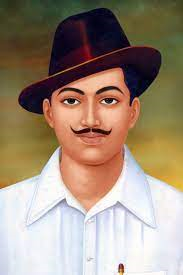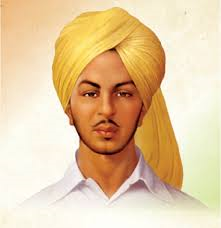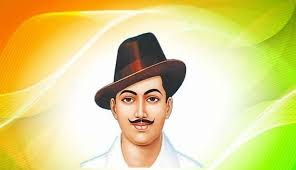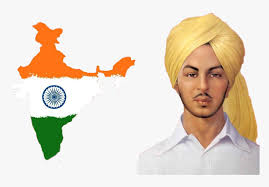Bhagat Singh - Biography
Bhagat Singh was an Indian freedom fighter who played a major role in Indian independence from British colonial control. Bhagat Singh belonged to a family of patriotic Sikhs known for their participation in anti-British revolutionary activities.

His father and uncles encouraged him significantly. He was drawn to anarchist and Marxist ideals as a young guy, which sparked revolutionary ideas in him. He was an eager reader and took an active part in extracurricular activities as a university student. He became a member of the 'Hindustan Republican Association,' afterwards known as the 'Hindustan Socialist Republican Association,' or HSRA, in 1928. Lala Lajpat Rai, who was wounded in a fight with the 'Simon Commission,' held him in high respect. Singh had planned to attack John Saunders, the British police officer, when Rai died a few months later. While incarcerated, he received a lot of support from fellow patriots. His assassination bolstered the rebels' resolve to fight for freedom. He put bombs inside the 'Central Legislative Assembly' to escape being arrested before surrendering to the authorities. When he was jailed, he had a lot of sympathy from other nationalists. His execution bolstered the rebels' willingness to fight for freedom. Despite his strong anti-British mentality, he became a legend in the Indian independence struggle.
Childhood:

On September 28, 1907, Bhagat Singh was born in Banga, Jaranwala Tehsil, Lyallpur District, Punjab, British India, to a Punjabi Sikh family. His father was a member of the "Ghadar" Party, as were two of his relatives. They also participated in the fight for Indian independence. Due to their involvement in revolutionary activities, they were imprisoned at the moment of Bhagat Singh's birth. Bhagat Singh attended the 'Dayanand Anglo-Vedic High School for his elementary education,' a 'Arya Samaji institution. He grew up a patriotic young man, inspired by his father and uncles, and wanted to devote his life to the independence movement. After becoming disillusioned with Gandhi's nonviolence doctrine, he joined the 'Young Revolutionary Movement.' In 1923, he enrolled at Lahore's 'National College.' During this time, his role in the freedom movement gained strength. He became a member of the 'Hindustan Republican Association,' which included significant figures such as Chandrashekhar Azad, Shahid Ashfaqallah Khan, and Ram Prasad Bismil, who fuelled his patriotic zeal. In 1928, the organization was renamed 'Hindustan Socialist Republican Association' (HSRA) at Singh's suggestion.
His Struggle for Freedom:
Gandhiji's trust in nonviolence was shaken when he resigned from the movement after the Chauri Chaura incident. Armed revolt, he thought, would be the only way to force the British out of the country. After examining the lives of revolutionaries in Italy, Ireland, and Russia, he is assured of his conviction.
He joined National College, that was founded by great patriots such as Lala Lajpat Rai and is still sponsored by great patriots such as Lala Lajpat Rai. During the day, he would attend studies in the evening, and discuss the revolution with his friends. He approached Bengal revolutionary party leader Sachindranath Sanyal and requested him to join his group. However, he only could join the party if he was willing to leave his house immediately if necessary. He had to come home to take care of his sick grandmother. He accepted and left home under the crisis of his upcoming marriage. He arrived in Kanpur and made a living selling newspaper. A rebel named Ganesh Vidyarthi offered him a job at his monthly office. He was an active supporter of the Akali Dal's meetings. He relocated to Lahore and became the secretary of the Naujawan Bharat Sabha.
He was arrested after authorities suspected him of being involved in the Dussehra blast. Two affluent men helped him get out of jail. He left for Delhi after running his father's diaries for a while. Bhagat decided to join Chandrasekhar Azad because he was totally committed to achieving freedom through revolution. He shaved his beard and kept his hair cut and short. After that, he learned how to construct bombs from Jatin Das in Kolkata. In Agra, they established a bomb factory. Despite the fact that they were unable to eat, they continued their activity.
National Movement & Revolutionary Activities:

Initially limited Bhagat Singh's actions to writing scathing articles about the British government and printing and distributing leaflets explaining the ideals of a violent revolt aimed at toppling the government. Because of his prominence among the youth and his ties to the Akali movement, he became a target for the government. The police apprehended him in connection with an explosion in Lahore in 1926. He was released on a 60,000 rupees bond five months later.
On October 30, 1928, Lala Lajpat Rai arranged an all-party protest against the Simon Commission's entry at the Lahore railway station. To stop the protesters from moving further, the police used a savage lathi charge. Lala Lajpat Rai was hurt badly in the fight and died on November 17, 1928, as a result of his injuries. Bhagat Singh and his friends planned the death of Superintendent of Police James A. Scott. He was thought to have ordered the lathi charge retaliation for Lala Lajpat Rai's death. J.P. Saunders, an Assistant Superintendent of Police, was mistaken for Scott by the revolutionaries, who executed him instead. Bhagat Singh fled Lahore immediately to avoid being apprehended. He cut his beard and chopped his hair to avoid bring being recognized, violating one of Sikhism’s most basic teachings.
The Hindustan Socialist Republican Association (HSRA) planned a terrorist attack within the assembly building where the law was to be passed in retaliation to the formation of the Defense of India Act. Bhagat Singh and Batukeshwar Dutt burst a bomb in the parliament chambers on April 8, 1929, shouted "Inquilab Zindabad!" and dropped a paper explaining their goal. Although the bomb was not intended to kill or damage anyone, tossed it away from the packed area; some council members were injured due to the unrest. Both Bhagat Singh and Batukeshwar Dutt were arrested after the bombings.
Bhagat Singh's Thoughts & Opinions:
Since he was a child, Bhagat Singh's patriotism had been planted in his mind. He grew raised to value nationalism and yearned for an independent India free of the British. Following significant research, he developed a socialist viewpoint. Reading European literature and having a good time desiring for his beloved's future to be a democratic country. While being born a Sikh, Bhagat Singh became an atheist after seeing multiple Hindu-Muslim clashes and other religious disputes. Singh argued it could only accomplish something as valuable as independence via a thorough cleansing of imperialism's exploitative essence. He believed that such transformation could only achieve through an armed revolution, analogous to the Bolshevik Revolution in Russia. He coined the phrase "Inquilab Zindabad," which became a rallying cry for the Indian independence movement.
Popularity & Reputation:
Bhagat Singh was a perfect icon for his generation's youth because of his passionate patriotism and developed idealism. He became the voice of his generation by speaking out against the British Imperial Authority and writing about it. Many have condemned his adamant departure from Gandhi's nonviolent path to Swaraj. Still, his brave embrace of martyrdom spurred hundreds of teenagers and young people to join the independence cause enthusiastically. Bhagat Singh was declared the Greatest Indian in an India Today poll in 2008, beating both Mahatma Gandhi and Subhash Chandra Bose.
Bhagat Singh in Popular Culture:

The popularity of films and theatrical renditions of Bhagat Singh's life reflects the motivation he continues to inspire among Indians. Several films based on the life of a 23-year-old rebel have been filmed, including "Shaheed" (1965) and "The Legend of Bhagat Singh" (2002). Popular Bhagat Singh songs, such as "Mohe ring de Basanti Chola" and "Sarfaroshiki Ta manna," continue to instil patriotism in Indians. His life, views, and legacy have been the subject of numerous books, essays, and papers. Bhagat Singh is also well-known on social networking networks. On the video-sharing website YouTube it’s possible to discover, that there are several videos on the firebrand revolutionary's life, including the Life Story of Bhagat Singh.
Death:
Bhagat Singh and his companions Rajguru and Sukhdev were hanged at Lahore Jail on March 23, 1931, at 7:30 a.m. The trio is alleged to have marched merrily towards the gallows while singing slogans such as "Inquilab Zindabad" and "Down with British Imperialism." On the banks of the Sutlej River, at Hussainiwala, Singh and his comrades were cremated.